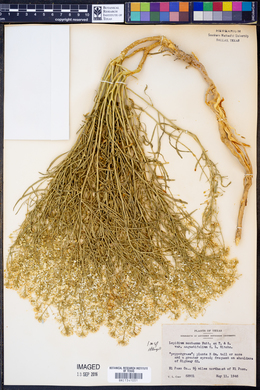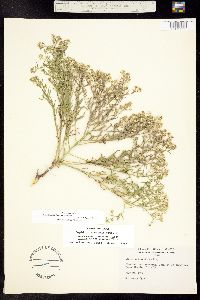Lepidium alyssoides
|
|
|
|
Family: Brassicaceae
Mesa Pepperwort, more...southern pepperweed
[Lepidium alyssoides var. minus Thell., moreLepidium alyssoides var. polycarpum Thell.] |
Perennials or subshrubs; (woody base often aboveground); glabrous or minutely puberulent. Stems few to several from base, erect to ascending, branched throughout, (0.7-)1-4.8(-6.1) dm. Basal leaves often not rosulate; petiole 1-6 cm; blade pinnately lobed, (1-)1.5-8(-11) cm × (5-)10-35 mm, margins (of lobes) entire or denticulate. Cauline leaves sessile; blade linear, (0.8-)1.3-7(-9.5) cm × (0.7-)1-2(-3) mm, base attenuate, not auriculate, margins entire. Racemes elongated in fruit; rachis puberulent or glabrous. Fruiting pedicels divaricate to horizontal, straight or recurved to somewhat sigmoid, (terete), 3.5-8(-11) × 0.2 mm, glabrous or puberulent adaxially. Flowers: sepals ovate to oblong, 1-2 × 0.8-1 mm; petals white, suborbicular, 2-3 × 1-2 mm, claw 0.5-1.5 mm; stamens 6; filaments 1.5-2 mm, (glabrous); anthers 0.2-0.4 mm. Fruits broadly ovate, 2-3.7(-4.3) × (1.5-)1.8-2.9(-3.4) mm, apically winged, apical notch 0.1-0.3(-0.4) mm deep; valves thin, smooth, not veined, glabrous; style 0.2-0.6 mm, exserted beyond apical notch. Seeds ovate, 1.5-1.8 (-2) × 0.9-1.2(-1.5) mm. 2n = 32. Flowering May-Jul. Pinyon-juniper or sagebrush communities, prairies, grasslands, sandstone outcrops, gypsum flats, sand dunes, dry flats and river bottoms, gravelly roadsides; 1200-2800 m; Ariz., Colo., Nev., N.Mex., Tex., Utah, Wyo.; Mexico (Chihuahua, Coahuila, Nuevo León, San Luis Potosí). Of the five varieties of Lepidium alyssoides recognized by R. C. Rollins (1993), one (var. mexicanum Rollins) is a short-tufted form of the species restricted to Mexico that does not seem to merit recognition, another (var. junceum) is a glabrescent form of the type variety, a third (var. eastwoodiae) is treated below as a distinct species, and the fourth (var. angustifolium) is included here within L. alyssoides.
FNA 2010, Kearney and Peebles 1969, Heil et al. 2013, Allred and Ivey 2012 Duration: Perennial Nativity: Native Lifeform: Subshrub General: perennial Leaves: Basal leaves persistent (not early-withering), not necessarily clustered in a rosette, on 1-6 cm petioles; stem leaves alternate, sessile; blades leaves pinnately lobed (lower) to linear (upper), 1-11 cm long and up to 3.5 cm wide, with entire to slightly toothed margins. Flowers: Small and white, in dense racemes at branch tips; on pedicels 3-11 mm long, ascending in flower and horizontal when in fruit; sepals 4, ovate, 1-2 mm long, deciduous; petals 4 in a cross formation, 2-3 mm long, suborbocular, white. Fruits: Capsules strongly flattened, oval shaped to round, 2-4 mm long and 2-3 mm wide, with a shallow notch and persistent style at the tip; seeds 1 per locule, brown, ovate, 1.5 mm long. Ecology: Found on gypsum flats, sandstone outcrops, dry flats, river bottoms, and gravelly roadsides, in sand dune, prairie, grassland, piyon-juniper, and sagebrush communities, from 4,000-9,000 ft (1219-2743 m); flowers May-July. Distribution: AZ, CO, NV, NM, TX, UT, WY; south to MEX. Notes: Lepidium is a genus in the mustard family with distinctive small, round, flat seed pods and small white flowers. L. alyssoides distinguished based on this combination of traits: perennial with a stout woody base (not rhizomatous); upper stem leaves sessile but not clasping the stem; racemes of flowers located at the tips of branches; fruit not wrinkled; lower leaves pinnately lobed and stem leaves entire or slightly toothed; middle stem leaves 1-3 mm wide; seed pods broadly ovate. Ethnobotany: Unknown, but other species in the genus have uses. Editor: LCrumbacher2012, AHazelton 2017 Etymology: Lepidium comes from the Greek lepidion, meaning "a little scale," in reference to the flattened shape of the seed pods; alyssoides means like genus Alyssum, because of the dense showy clusters of white flowers. |











































































